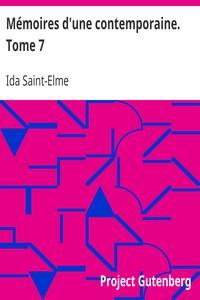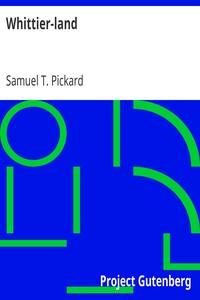|
|
Read this ebook for free! No credit card needed, absolutely nothing to pay.Words: 20517 in 6 pages
This is an ebook sharing website. You can read the uploaded ebooks for free here. No credit cards needed, nothing to pay. If you want to own a digital copy of the ebook, or want to read offline with your favorite ebook-reader, then you can choose to buy and download the ebook. BY THE LATE CHARLES MEYMOTT TIDY, M.B., M.S., F.C.S. FORMERLY BARRISTER-AT-LAW; PROFESSOR OF CHEMISTRY AND OF FORENSIC MEDICINE AT THE LONDON HOSPITAL; MEDICAL OFFICER OF HEALTH FOR ISLINGTON; VICE-PRESIDENT OF THE INSTITUTE OF CHEMISTRY; ONE OF THE OFFICIAL ANALYSTS TO THE HOME OFFICE. LONDON: SOCIETY FOR PROMOTING CHRISTIAN KNOWLEDGE, NORTHUMBERLAND AVENUE, W.C.; 43, QUEEN VICTORIA STREET, E.C. BRIGHTON: 129, NORTH STREET. NEW YORK: E. & J. B. YOUNG & CO. 1897. PREFACE These lectures were delivered with the assistance merely of a few notes, the author in preparing them for the press adhering as nearly as possible to the shorthand writer's manuscript. They must be read as intentionally untechnical holiday lectures intended for juveniles. But as the print cannot convey the experiments or the demonstrations, the reader is begged to make the necessary allowance. The author desires to take this opportunity of expressing his thanks to Messrs. Bryant and May; to Messrs. Woodhouse and Rawson, electrical engineers; to Mr. Woolf, the lead-pencil manufacturer; and to Mr. Gardiner, for numerous specimens with which the lectures were illustrated. THE STORY OF A TINDER-BOX Well, you all know what this is? It is a box of matches. And you know, moreover, what it is used for, and how to use it. I will take out one of the matches, rub it on the box, and "strike a light." You say that experiment is commonplace enough. Be it so. At any rate, I want you to recollect that phrase--"strike a light." It will occur again in our course of lectures. But, you must know, there was a time when people wanted fire, but had no matches wherewith to procure it. How did they obtain fire? The necessity for, and therefore the art of producing, fire is, I should suppose, as old as the world itself. Although it may be true that our very earliest ancestors relied for necessary food chiefly on an uncooked vegetable diet, nevertheless it is certain that very early in the history of the world people discovered that cooked meat was a thing not altogether to be despised. Certainly by the time of Tubal Cain, an early worker in metals, not only the methods of producing fire, but also the uses to which fire could be applied, must have been well understood. Imagine the astonishment of our ancestors when they first saw fire! Possibly, the first sight of this wonderful "element" vouchsafed to mortals was a burning mountain, or something of that kind. One is scarcely astonished that there should have been in those early times a number of people who were professed fire-worshippers. No wonder, I say, that fire should have been regarded with intense reverence. It constituted an essential part of early sacrificial worship. Some of my young friends, too, may remember how in ancient Rome there was a special order , whose duty it was to preserve the sacred fire, which if once extinguished, it was thought would bring ruin and destruction upon their city. Talking about friction as a means of producing heat, I should like to mention that at the last Paris Exhibition I saw water made to boil, and coffee prepared from it, by the heat resulting from the friction of two copper plates within the liquid. That then is the earliest history I can give you of the production of fire, and at once from that history I come to the reign of the tinder-box. The tinder-box constitutes one of the very earliest methods, no doubt, of obtaining fire. I have searched for some history of the tinder-box, and all I can say for certain is that it was in use long before the age of printing. I have here several rare old tinder-boxes. I intend showing you in the course of these lectures every detail of their construction and use. I have no doubt this very old tinder-box that you see here was once upon a time kept on the mantel-piece of the kitchen well polished and bright, and I do not doubt but that it has lit hundreds and thousands of fires, and, what is more, has very often been spoken to very disrespectfully when the servant wanted to light the fire, and her master was waiting for his breakfast. I will project a picture of it on the screen, so that you may all see it. There it is. It is a beautiful piece of apparatus. There is the tinder, the steel , the flint , and the matches complete. It was with this instrument, long before the invention of matches, that our grandfathers obtained light. I want to show you how the trick was managed. First of all it was necessary to have good tinder. To obtain this, they took a piece of linen and simply charred or burnt it, as you see I am doing now . The servants prepared the tinder over-night, for reasons I shall explain to you directly. Having made the tinder, they shut it down in the box with the lid to prevent contact with air. You see I have the tinder now safely secured in my tinder-box. Here is a piece of common flint, and here is the steel. Here too are the matches, and I am fortunate in having some of the old matches made many years ago, prepared as you see with a little sulphur upon their tips. Well, having got all these etceteras, box, tinder, flint and steel, we set to work in this way:--Taking the steel in one hand, and the flint in the other, I must give the steel a blow, or rather a succession of blows with the flint . Notice what beautiful sparks I obtain! I want one of these sparks, if I can persuade it to do so, to fall on my tinder. There! it has done so, and my tinder has caught fire. I blow my fired tinder a little to make it burn better, and now I apply a sulphur match to the red-hot tinder. See, I have succeeded in getting my match in flame. I will now set light to one of these old-fashioned candles--a rushlight--with which our ancestors were satisfied before the days of gas and electric lighting. This was their light, and this was the way they lighted it. No wonder that they went to bed early. I should like to draw your attention to one other form of tinder-box, because I do not suppose you have ever seen these kind of things before. I have here two specimens of the pistol form of tinder-box . Here is the flint, the tinder being contained in this little box. It is the same sort of tinder as we made just now. The tinder was fired with flint and steel in the same way as the old-fashioned flint pistols fired the gunpowder. And you see this pistol tinder-box is so constructed as to serve as a candlestick as well as a tinder-box. I have fired, as you perceive, my charred linen with this curious tinder-box, and thus I get my sulphur match alight once more! Shortly after phosphorus had been discovered, people came to the conclusion that it might be employed for the purpose of procuring artificial light. But I want you to note, that although phosphorus was discovered in 1669 , it was not until the year 1833 that phosphorus matches became a commercial success, so that until the year 1833, our old friend the tinder-box held its ground. I will try and give you as nearly as I can a complete list of the various attempts made with the purpose of procuring fire between the years 1669 and 1833. Free books android app tbrJar TBR JAR Read Free books online gutenberg More posts by @FreeBooks
: Mémoires d'une contemporaine. Tome 7 Souvenirs d'une femme sur les principaux personnages de la République du Consulat de l'Empire etc... by Saint Elme Ida - France History 1789-1815 FR Biographie Mémoires Journal intime Correspondance@FreeBooksWed 07 Jun, 2023

: Whittier-land A Handbook of North Essex Containing Many Anecdotes of and Poems by John Greenleaf Whittier Never Before Collected. by Pickard Samuel T Samuel Thomas - Whittier John Greenleaf 1807-1892 Homes and haunts Massachusetts Essex County; Literary l@FreeBooksWed 07 Jun, 2023
|
Terms of Use Stock Market News! © gutenberg.org.in2025 All Rights reserved.






